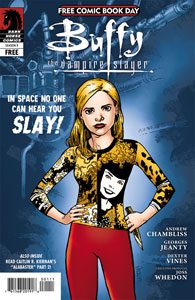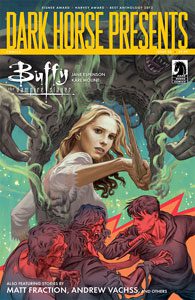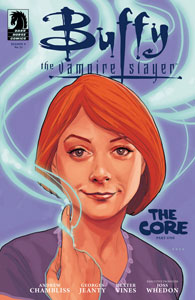Writer Andrew Chambliss and artist Georges Jeanty stick the landing to conclude the character-driven yet suitably epic “Buffy” Season 9 with the five-issue “The Core.” It’s a crying shame that this marks Chambliss’ finale in the Buffyverse. He gets the saga back on track after the uneven Season 8 and keeps threads percolating for Season 10, to be written by “Angel & Faith” Season 9’s Christos Gage — who is really good, but not quite as good as Chambliss. Also in this post, I take a look at the season’s special issues.
“The Core” (Issues 21-25, May-September 2013)
Season 9 wraps with perfection on par with Seasons 2 and 5, giving us good-to-great character moments for everyone and adding in an epic setting only possible in comic-book pages. Chambliss and Jeanty take us to the England-based Deeper Well from “A Hole in the World” (“Angel,” 5.15) and “Illyria: Haunted,” and deliver fights amid the vertical stacks of sarcophagi.
In addition to being a visually awesome setting, the return to Illyria’s resting-and-rebirth place ties in nicely with the current story on a couple levels. Primarily, there’s Dawn’s situation. She’s disappearing along with the magic in the world. Willow and Illyria help Severin (who was misguided, not evil) put his gathered magic power into a seedling, thus creating a new Seed; this will restore Dawn to full health – and full existence.
The way Dawn – whose increasingly ghostly form is nicely rendered by colorist Michelle Madsen – gradually forgets her family and friends, and the way they forget her, parallels Fred fading away in “A Hole in the World,” and serves as a powerful metaphor for people with dementia and the relatives who suffer along with them. Dawn is a maguffin and a rallying point more so than a character in Season 9, but since we all love Dawn, it works perfectly, and I expect our patience will be rewarded with an actual arc for Dawn in Season 10.
The Illyria arc in “The Core” is more subtle, but it’s cool. She wonders how she is still alive despite her powers being gone. It’s not explicitly spelled out by Chambliss, but I think it’s because Illyria had acquired more human-style goodness – from imitating what the Angel Investigations team saw in Fred – than even she herself realized. So rather than retconning the IDW “Angel” issues, as I initially thought “Buffy” Season 9 was doing, it brilliantly uses them as part of Illyria’s story.
Although Season 9 is less Big Bad-centric than any prior season, Simone Doffler goes out as a strong villain. Her desire to turn herself into a Slayer vampire – a “Slaypire,” as Xander immediately coins the term – is wonderfully creepy, and it’s neat that we encounter Maloker, the First Vampire, paralleling the First Slayer. The notion of a Slaypire isn’t new to the spinoff fiction – see Yuki from “False Memories” and Celina from “Tempted Champions” – but this is the first Slaypire in the canon unless you count the temporary Vampire Buffy in “Nightmares” (“Buffy” 1.10). But Simone is different; sired by the First Vampire, she is more powerful and retains her twisted human mind.

Some Season 9 threads are left on the shelf for Season 10 to pick up. Koh doesn’t learn the identity of the enemy who imprisoned him. A Buffy-Dowling romance is teased but put on hold. But overall, Chambliss delivers a complete and satisfying 25 issues, and it’s because he sticks to the mission statement of focusing on Buffy, a contrast to Season 8, in which the plot (and not a good one) ends up overshadowing the people. Willow going off-panel to acquire some magic would be odd except that we know that tale is told in “Willow: Wonderland,” so it’s not a plot hole. The lone halt to the momentum is the “Billy the Vampire Slayer” sidebar story, the only time Chambliss hands off writing duties.
Otherwise, Season 9 has a forward-moving narrative, with Chambliss knowing all the characters and their speech rhythms, while never drifting into overly cutesy dialog like other comic writers do. Yet he doesn’t sacrifice an epic scope, with the finale at the Deeper Well working much better than the overblown, multi-front battle that closes Season 8. Jeanty is more dialed in this time, too, as I never struggle to realize who is who in the battle.
5 stars
In addition to “Buffy,” “Angel & Faith,” “Willow” and “Spike,” Season 9 features three side stories. In digital-only format came the Spike story “Magical Mystery Tour, Featuring the Beetles” (August 2011), which is no longer available at the Dark Horse website, followed by two others:

“In Space, No One Can Hear You Slay” (Free Comic Book Day, May 2012)
In this entirely-just-for-fun eight-pager, Spike and Buffy are on vacation on his bug spaceship with the corpse of a bug killed by zompires. It has risen as a “bug-pire” (Spike’s clearly not as good at inventing terms as Xander is). Coincidentally, the bug-pire looks exactly like an “Alien” xenomorph; not coincidentally, Dark Horse had the license to both properties.
Chambliss and Jeanty pay homage to “Alien” (1979) as Buffy stalks the ship a la Ripley, with Spike providing instruction a la Dallas. The molting bug mirrors the alien going through its life cycle. Bug spray annoys it – see also “Killing Time” (Dark Horse Presents No. 150, 2000) – but ultimately it’s more vampire than xenomorph (even though, again, it looks exactly like a xenomorph), and the key to victory lies in the solarium.
4 stars

“Love vs. Life” (Dark Horse Presents Issues 25-27, June-August 2013)
Writer Jane Espenson brings Billy back to his hometown of Santa Rosita to help fight off a zompire infestation. Like the “Billy the Vampire Slayer” two-parter, this story (the equivalent length of one issue) puts gay teens Billy and Devon (his “Watcher”) into a clichéd situation usually occupied by straight people. Thus, it becomes notable for its very averageness – although it is better than Billy’s first appearance because it’s tighter and has fun concepts. For instance, Karl Moline draws a van loaded with stakes in its grill (I think Gunn’s gang used this method on “Angel”) for plowing through zompires.
Buffy tells Billy he can’t fight side-by-side with Devon (the extent of whose characterization is “Billy’s boyfriend”), because it will distract him – even though she fights alongside boyfriends all the time – and is even doing it right now with Dowling — but I guess that’s why she’s wise about the issue. But she’s still wrong. I’ve always hated the notion that superheroes should dump their significant others in order to protect them; it usually makes no logical sense, and often leads to other problems. “Love vs. Life” is a case in point, because even though Billy dumps Devon, whaddaya know, Devon’s still in danger. At least Billy quickly learns the folly of his ways.
3 stars
Click here for an index of all of John’s “Buffy” and “Angel” reviews.

